How London's Low Winter Light, Wide Master Primes and Intimate Camera Work Let 35mm Reign Supreme

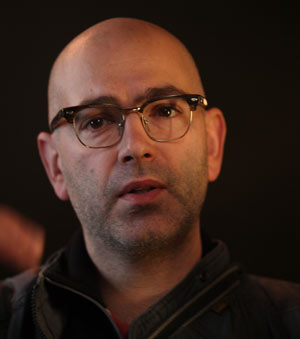
StudioDaily: The King’s Speech gives us the very intimate backstory of a very public memory but there are only a few grand, exterior locations. Most of the primary interior scenes are shot in one place-Lionel Logue’s basement office. How much was determined by budget and how much was a conscious creative choice?
Danny Cohen: It really was a combination of both. As a UK-based film it didn’t have a very big budget. It made sense for us to play to our strengths. We lucked out when we found the Portland Place location for Lionel Logue’s consulting room, which was a character in itself.
SD: Was there a lot of art direction going on at that location, particularly with the mottled wallpaper you see behind Colin Firth in so many shots?
Our production designer, Eve Stewart, found the room and the ripped up wallpaper was there, and they just extended it so it covered a larger area of the wall to became a larger set. The logic was that I don’t think anybody would ever design something that looked like that. It just caught Tom’s imagination. It was a crazy location in that way, because it essentially was something that you wouldn’t have seen before, especially back in 1930s London. But it was a visual representation of what’s going on inside the head of Colin’s character. I’ve done a couple of films with Tom, including half of the John Adams series. He did a similar thing there, where he wanted authenticity that would make the human drama believable. In that case, it was about seeing the dirt under people’s fingernails; it was gritty and dirt was everywhere. On The King’s Speech, that location certainly helped give those scenes a rougher, warmer, more human edge.
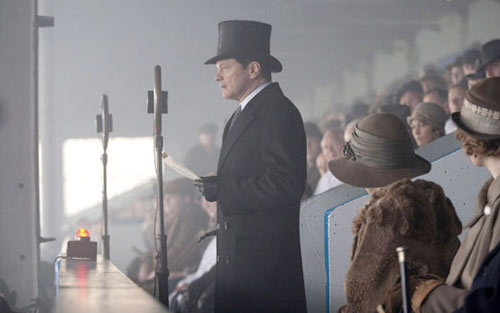
Colin Firth, as the Duke of York, gives the film’s opening speech at Wembley
Stadium to disastrous results.
SD: You also got in very close to the actors’ faces in these scenes in Logue’s office, underscoring the immense pressure the king is under. That wallpaper, however, was still very much in focus. How did you frame these shots?
Basically, Tom’s starting point was that this is a historical drama. By and large, all British historical dramas have the same look: you have faces set against out-of-focus backgrounds. What Tom was trying to do was to open that up, so we used very-wide-angle [ARRI] Master Prime lenses and consequently could get much closer to the actors’ faces. We were literally putting cameras one or two feet away from each of their faces. A lot of interesting things happen when you put the camera so close to the actor. For one, you get nice big portraits, which you wouldn’t get with long lenses that are much farther away. But you also get so much more of the background that you instantly see where the person is. It’s not just out-of-focus mush; it contextualizes where the person is in the room, or in those larger scenes, for example in the Abbey before his coronation. That’s where the reality comes in-you’re putting them in a real location that’s an equally important part of the scene.
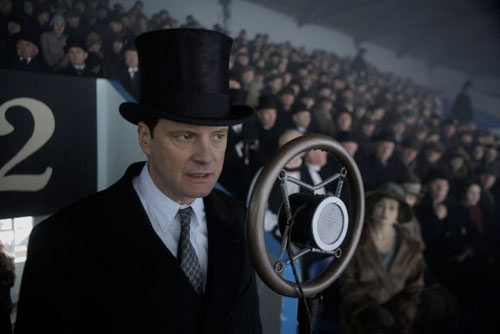
Danny Cohen’s use of wide ARRI Master Prime lenses and a variety of rigs let him pull in close to the actors’ performances without sacrificing the scope of the larger scene.
SD: How did the actors react to such close camera work?
There always was a degree of trust on set, and we never wanted to shoot them in an unflattering way. It came down to fitting the right lens with the right actor so that we could put the audience right in front of their face. The whole film is about language and not being able to speak, and Tom wanted that intimacy, to pull the audience into the story. It’s as if you can feel Colin’s breath on your face. It’s really nothing new in filmmaking, but it’s a slightly different take on the historical drama.
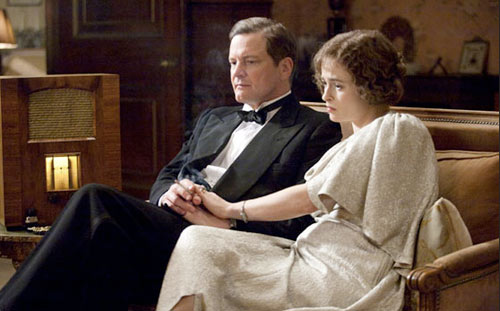
Firth with actress Helena Bonham Carter as the ever-patient Queen Elizabeth
SD: You seemed to be shooting with very naturalistic light. What kind of lighting setup did you have for these interior scenes?
All the lights were outside of the room, and I kind of liked shooting that way, particularly because it also gave the actors a sense of added freedom. We weren’t pinning them down amongst a forest of lights; it was just really the camera and the operators with them in the room. You still had to be quite free with the camera, moving on Steadicam or on track or on a crane, all the normal processes you use in shooting a film. We felt that if we brought everything in closer, you can squeeze a lot more emotion out of the scene. But I think it always helps move the story along if you don’t over-complicate it with fancy crane moves. It makes it simpler if you’re not struggling to contain a scene within a shot because you’ve got something in your head that says it’s got to be a track move, or whatever.
SD: Did you shoot anything handheld?
Yeah, we did. The montage scene where Colin Firth is going through his vocal exercises, for example. We shot almost all of that handheld, save for one dolly shot, in 20 minutes at the end of the day. We had a time constraint (we were losing the afternoon light) so we had to figure out the quickest way to shoot it. We decided it was best to put the camera on the shoulder and shoot it really simply. The process of filmmaking invites so many ideas and strong points of view, but the reality on set is most decisions are made by necessity. Usually it’s a time constraint: the sun is going down or it’s starting to rain. At the end of the day you’ve just got to be flexible. You can’t impose your will on certain laws of nature. If the sun goes down at 4 o’clock, it goes down at 4 o’clock. We still had a whole rig of lights up in the skylight at Logue’s office, for example, and could control them, to a degree, to get the consistency we needed. But using natural light, combined with simulated light from logical natural sources, adds to the authenticity of the design of a film. When you try to light from the outside in, it just gives your talent so much more room to create. In Geoffrey Rush’s case, this worked in his favor. He played Lionel as a kind of live wire with lots of energy. It would have been a real shame if he couldn’t use that energy, and he wouldn’t have been able to if he was restricted by too much gear. And that’s just down on the ground. The beauty of the sets on this film was that even the interiors we shot in had fantastically high ceilings. The Portland Place location is a Georgian townhouse. The reason we didn’t shoot the film widescreen and we shot regular 1.85 aspect ratio was because we didn’t want to lose all that height. We wanted to exploit that frame to its best advantage.
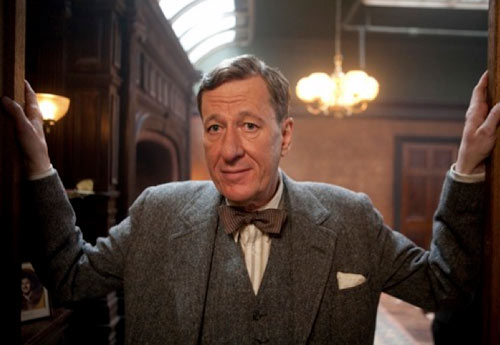
Geoffrey Rush, playing the unconventional speech therapist Lionel Logue, in a scene shot at 33 Portland Place, the “shabby chic” Georgian townhouse one block away from where the real Logue originally practiced.
SD: What was in your lens kit?
We had a full range of Master Prime lenses. What’s great about Master Primes is they have an insane range of lenses, from 10, 14, 16, 18, 21, 25, 27, 33-a huge spread, which gives you a good choice. What’s peculiar is that even though the jump in the lens size is 3 millimeters, just by having that degree of choice, it can change the complete angle of view and how the face films. That range also meant that there was always the right lens for the right scene. You always go through a bunch of lenses first when setting up a scene to work out what the camera is doing in relation to the actor. Because of the range, we knew there would always be a lens that would let us film exactly what we wanted.
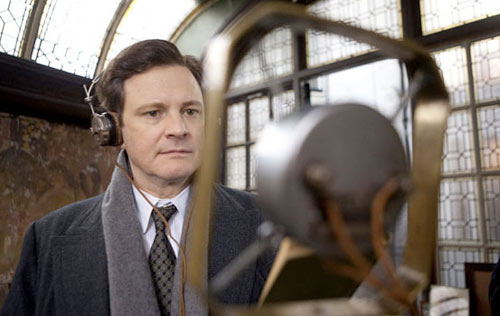
Logue’s office features richly textured, distressed walls, leaded windows and a massive skylight, all characters in their own right that Cohen says production designer Eve Stewart left largely as she first found them, only extending the mottled effect across one entire wall.
SD: There are a few striking long shots in the film-the opening scene at Wembley Stadium, inside Westminster Abbey and the pivotal scene in Regent’s Park. How did you shoot those scenes in contrast?
We shot most of the park scene on Steadicam because it was walking and talking. And with the Steadicam, we typically used a 21, 25 or 27mm lens.
SD: What was the most difficult scene to shoot?
The time constraints imposed by the time of year when we shot this film was probably the most challenging aspect of it, not any one scene. We shot during the winter in London, so we knew it would be getting dark every day at 4 or half past 4 o’clock in the afternoon. Unless we were in the studio, where we could control the lights, we had to shoot everything with this in mind. On big-budget pictures where you can afford to shoot everything in a studio you always do, because there’s just so much more control. In reality, on a smaller budget film, where the bulk of the work is on location, you have to go with the flow a lot more.
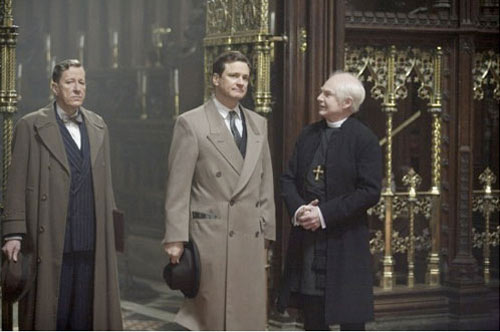
Just another day at the office: The King arrives at Westminster Abbey (Ely Cathedral in Cambridgeshire) with Logue in tow to rehearse his coronation. The Archbishop of Canterbury (Derek Jacobi) welcomes his boss.
SD: There is a smoky haze pervading most of the outside scenes, characteristic of London at the time. How difficult was that to simulate and shoot?
It was pretty challenging during the Regent’s Park scene or Harley Street scenes to get the scale of that smoke, which essentially was smog, just right. We were quite lucky in Regent’s Park that it was quite a still, windless day. We had lots of smoke machines, but if there had been any wind, it would have all disappeared instantly. The light was absolutely perfect-the angle of the low winter sun through the smoke just created these long beautiful shadows. We really lucked out. The low light at the end of the year is a bit more atmospheric, which really worked for us. If you shoot in spring or summer, the light’s higher and harsher. The down side, however, was I think it was one of the coldest films I’ve ever worked on. It was a freezing winter last year in London. But again, that coldness in the exterior shots translates into the film you watch. On the outside, here was this cold, upper-class heir to the throne. But on the inside, there is a warmth and a humanity.
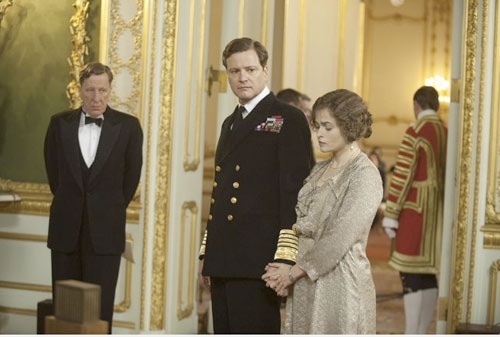
Logue stands at attention in Buckingham Palace (filmed on location at Lancaster House, a London mansion from a similar time period) as their majesties cope with the pressure of the King’s impending speech to the nation.
SD: Do you prefer to shoot on film?
I’ve been really lucky that the bulk of my work in the past five years has been on film. I’m a bit spoiled really and not in the real world, I admit. I’ve shot some films on HD and shoot commercials on video, but the bigger projects, like the next Johnny English film with Rowan Atkinson I just finished, have been on film. I just think you have a lot more flexibility when you shoot on film. HD is good for certain things, but there’s a simplicity and texture you get when you shoot on film. Money plays a huge part in what you shoot on these days. Everybody approaches the question of what format to shoot in with a completely different point of view. As a cinematographer, I think you still get the best images from film. Plus, there’s a consistency about the process: you can literally turn the camera on and shoot. You’re also not losing control of the film into post-production. With the RED, you have to go have a cup of tea before the camera’s ready to go. It’s a computer you stick a lens on, and it’s not very ergonomically designed. If you do a lot of running around and handheld work, it doesn’t feel like a naturally balanced camera. I’ve shot on RED and on ARRI’s D21, and both projects looked really good. But you can’t put the D21 on your shoulder, either, because it weighs too much. The ALEXA, as a shrunk-down version of the D21, is much more practical, and because ARRI has this long history in the film industry, it’s much more ergonomically designed. You can just pop it on your shoulder and go. I’ve got a project coming up next month in which I’ll be shooting with the ALEXA. We could have easily decided to shoot The King’s Speech on HD because it’s so dialogue heavy with long, 10-minute takes. In an ideal world, you make that format choice for aesthetic reasons, because technology is no longer an obstacle. But it’s never an ideal world.
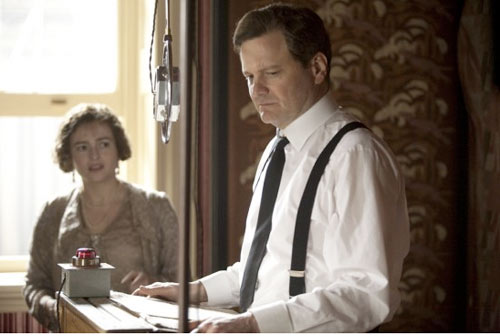
Cohen shot the eponymous climactic speech-staged by director Tom Hooper to juxtapose scenes of public reverence and stilled anticipation of the war with more intimate moments between husband and wife and the King and his instructor-in soft natural light from a nearby window.
SD: Who among the other Academy Award nominees for Best Cinematography this year most inspires you?
I’m a massive fan of Roger Deakins. Most of the seminal films that influenced me he’s shot. The Big Lebowski is one of my favorite films. In the mid-1980s, Deakins shot a small-budget thriller called Defense of the Realm. There’s nothing fancy about it, but it always felt to me that each frame just helped to tell the story. I think that’s what he consistently does: it’s not flashy at all. And he knocks them out every year.
Did you enjoy this article? Sign up to receive the StudioDaily Fix eletter containing the latest stories, including news, videos, interviews, reviews and more.








